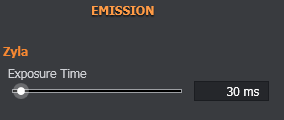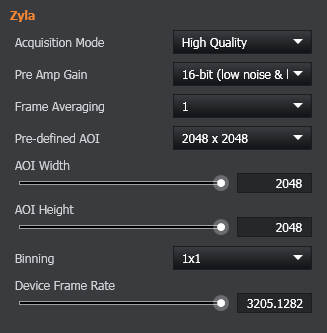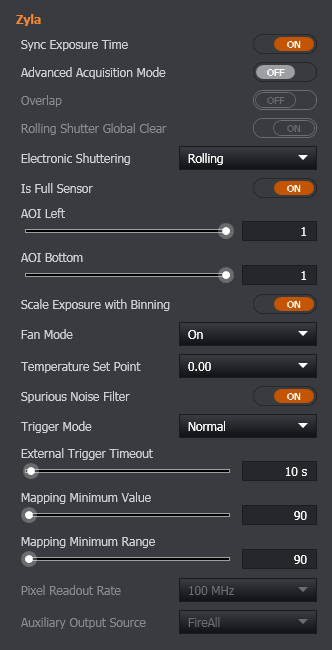Zyla and ZL41 Cell sCMOS Camera Settings
As described in the Image Mode and Feature Location section, device settings can be moved between Channel, Global, Image Mode and Advanced. Therefore, the settings described here may be found in a different location depending on the customisation / user of your Fusion installation. These settings are shared between the Zyla cameras and the updated ZL41 Cell sCMOS series.
Channel Settings

Exposure Time- this is the time that light will be collected on the sensor. Lower values will provide higher speed, but lower signal:noise / image quality / brightness / less total laser exposure to the sample. A starting value for this might be 100 ms.
Global Settings

Acquisition Mode - (Default High Quality). This setting automatically adjusts some of the Advanced Settings of the camera, simplifying its operation. Options are High Quality or High Speed. High Quality is recommended for general use. High Speed should only be used with a Finite Burst Protocol. See also Advanced Acquisition Mode in the Advanced Settings (below).
Pre Amp Gain - (Default "16-bit (low noise & high well capacity"). There are three options for ZL41 Cell and Zyla series cameras- "16-bit (low noise & high well capacity"; "12-bit (low noise)" and "12-bit (high well capacity)". For most cases, 16-bit mode should be used. In some cases, using a 12-bit mode may allow higher acquisition speeds, but will not reduce the size of the data as it will always be stored in a 16-bit file.
Frame Averaging - (Default 1) When set to values higher than 1, this will produce an image of the average of a number of frames. Its main purpose is to reduce spurious noise in the image. However, it would be better to increase the Exposure Time (unless this would lead to saturation of the image). Both options will decrease the speed, but increase the signal:noise / image quality / more total laser exposure to the sample.
Pre-defined AOI - (Default - full chip size) Allows the selection of a smaller AOI (Area of Interest) for imaging. This will reduce the size of the image (both on-screen and in total data size); allow lower exposure times to be used. It will not affect the area of the sample being illuminated - only the area being imaged.
AOI Width / Height - (Default is full chip resolution) These settings allow the AOI to be adjusted by single pixels. See also the Pre-defined AOI (Global Settings, above)
Binning - (Default 1x1) Binning allows the image to be reduced in XY resolution by combining (binning) pixels on the camera chip. Increasing values will lead to lower resolution images, smaller data sizes and shorter exposure times to be used. Binning will also increase the signal:noise of the image (but only by a factor of the binning used - for example, 2x2 binning will only increase the signal:noise by a factor of two. On an EMCCD, this would be a factor of four). Fusion will automatically adjust the exposure time to maintain the image intensity. See Scale Exposure with Binning option in the Advanced Settings section (below).
Device Frame Rate (Default is the maximum value) - Allows a limit to be placed on the camera, reducing the maximum frame rate transferred across the USB or CameraLink interface to the PC.
Advanced Settings

Sync Exposure Time - (Default ON) When used with a confocal system, such as the Andor Dragonfly, this option will set the exposure time to match the image scanning speed (based on the rotation of the spinning disk). Assuming a default rotation speed of 6000 rpm on Dragonfly, this will cause the exposure time to be rounded to the nearest 2.5 ms. Switching this setting off may lead to image artefacts and/or scan lines.
Advanced Acquisition Mode - (Default OFF). When ON, this will disable the Acquisition Mode setting in the Global Settings (see above), but unlock the Overlap, Rolling Shutter Global Clear, Pixel Readout Rate and Auxiliary Output Source features (see below).
Overlap - (Default OFF) When enabled, the exposure time and readout will happen in parallel, increasing the speed of acquisition. Note that this feature is only used in a Finite Burst protocol. In all other cases, it will not be used.
Rolling Shutter Global Clear - (Default ON) When enabled, a clear of the sensor will be executed to simulate a global shutter. This feature may not be available depending on the model of sCMOS being used.
Electronic Shuttering - (Default depends on the camera model). Depending on the model of sCMOS, there may only be Rolling available. This will be the highest speed option. If Global is available, this is a true global shutter, ensuring that the entire sensor is read at once. This will reduce the maximum speed of acquisition, but ensure that all areas in the image are captured at the same time. This may be relevant for imaging very fast moving large objects.
Is Full Sensor - (Default ON) This is linked / related to the Pre-defined AOI setting (see Global Settings section above) and the AOI settings (see below). When ON, it will reset the camera back to full chip mode.
AOI Left / Bottom - (Default is full chip resolution) These settings allow the AOI to be adjusted by single pixels. See also the Pre-defined AOI (Global Settings, above)
Scale Exposure with Binning - (Default ON) As described in the Global Settings section (see above), this will automatically adjust the exposure time when the binning is changed.
Fan Mode - (Default ON (Full) This allows the cooling fan in the camera to be slowed / stopped. It is strongly advised not to adjust this setting unless water-cooling is fitted to the camera. Changing this setting when using only air cooling may result in the camera overheating. It is unlikely to damage the camera, but will result in an overheating alarm to be triggered, requiring the software to be restarted and leaving the camera to cool before restarting.
Temperature Set Point - (Default 0 C) This allows the camera's target cooling temperature to be changed. This cannot be adjusted for Zyla and ZL41 Cell cameras.
Spurious Noise Filter - (Default ON). This setting should be enabled. It reduces the random noise that can sometimes be seen with sCMOS sensors.
Trigger Mode - (Default NORMAL). This is an advanced feature that allows the camera's Ext Trigger input pin / cable to either Start an acquisition, or take a single Exposure.
External Trigger Timeout - (Default 10 seconds). Related to the Trigger Mode, this is the length of time the software will allow before producing an error message if it does not receive a trigger on the camera's Ext Trigger pin / cable.
Mapping Minimum Value - (Default - depends on the camera). Related to the Mappingof the image. This sets a minimum value that is allowed when using the mapping tools to control the on-screen brightness. It has no effect on the raw data / intensity of the image.
Mapping Minimum Range - (Default - depends on the camera). Related to the Mappingof the image. This sets a minimum range that is allowed when using the mapping tools to control the on-screen brightness. It has no effect on the raw data / intensity of the image.
Pixel Readout Rate - (Default - depends on camera model). As described above, this option will be greyed out and controlled by the Acquisition Mode setting, unless Advanced Acquisition Mode is enabled. Higher values will increase the maximum possible acquisition speeds.
Auxiliary Output Source - (Default - FireAll). As described above, this option will be greyed out and controlled by the Acquisition Mode setting, unless Advanced Acquisition Mode is enabled. This controls the behaviour of the Aux Out 1 pin / cable. On a Dragonfly confocal system, this is used to synchronise the excitation lasers by means of Active Blanking. If the wrong option is selected, image artefacts may result. See also Finite Burst Protocols.